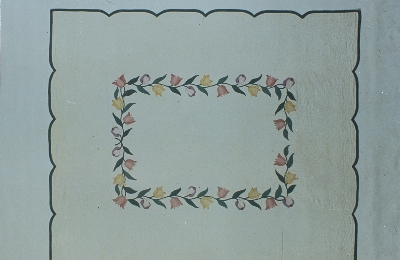Quilt No.5BG - Betty Gray

2240 x 885mm
The quilt top was made by Mrs Laura Hart, probably from a kit, sometime in the 1930s and 1940s. It was assembled and quilted by members of the Canadian Women's Association in Sydney. The finished quilt was raffled in the late 1940s and was won by an older Canadian woman. It was then purchased by Norma McMorran's mother, and recently (since 1995) given to the current owner, Betty Gray, the daughter of a Canadian war bride, in order to pass it on to the next generation - her daughter. It is being used by Betty Gray in the guest bedroom.
"The completed top, most likely made from a kit, was given by a Mrs Laura Hart to members of the Canadian Women's Association who met regularly in Sydney in the 1930s and 1940s to socialise and do charity work. Mrs Hart's husband was a senior executive with Colgate Palmolive and about 1946 was recalled to North America to a more senior position. When Mrs Hart was packing up the quilt top surfaced and she realised she was unlikely ever to complete the quilt, so she offered it to the Canadian Women's Association members with the suggestion that they finish it and raffle it. The offer was taken up and Mrs Helen Troy, an older Canadian who remembered quilting bees in her youth in Ontario, undertook to organise the project. She lived in a large house in Vaucluse. There were no children and many rooms and the quilt was put together and set up on a frame in one of the unused rooms. The project was organised along traditional lines. Quilting days were held regularly and any members of the Association who felt so inclined could go along and stitch� Mrs Troy was a perfectionist and any stitches she didn't consider up to standard were ripped out after the offending person had left. One elderly lady was a particular worry.
By this time it was 1946 or 1947 and many members of the group were war brides - Canadian girls who had married Australian RAAF men training in Canada and many of whom at this stage were battling homesickness, the problems of adopting to a new country and postwar conditions generally. Much homesickness was talked out over the quilting frame and many problems aired. The whole project proved an excellent therapy for these girls.
Eventually the quilt was finished and it was raffled. It was won by an older Canadian woman who shortly after with her husband gave up their home and moved to a boarding house, putting their furniture and household effects including the quilt into storage. My mother was sad that the quilt had not gone to someone who would enjoy it and offered to buy it. The offer was accepted and that is how it came into our possession.
� We always felt the Tulip quilt too special for everyday use and it has only been brought out on special occasions. It is also a difficult size - too big for a single bed and too small for today's double beds. Perhaps double beds were smaller in the 1930s. Probably it was intended to be displayed with a skirt around the bed. Whenever we have displayed it, it has been admired and on many occasions involving Canadians I have been amazed at the people who have exclaimed 'I worked on that quilt!'."
[Norma McMorran, Sydney, September 1991]
Related Quilts:
2236 x 2236mm






